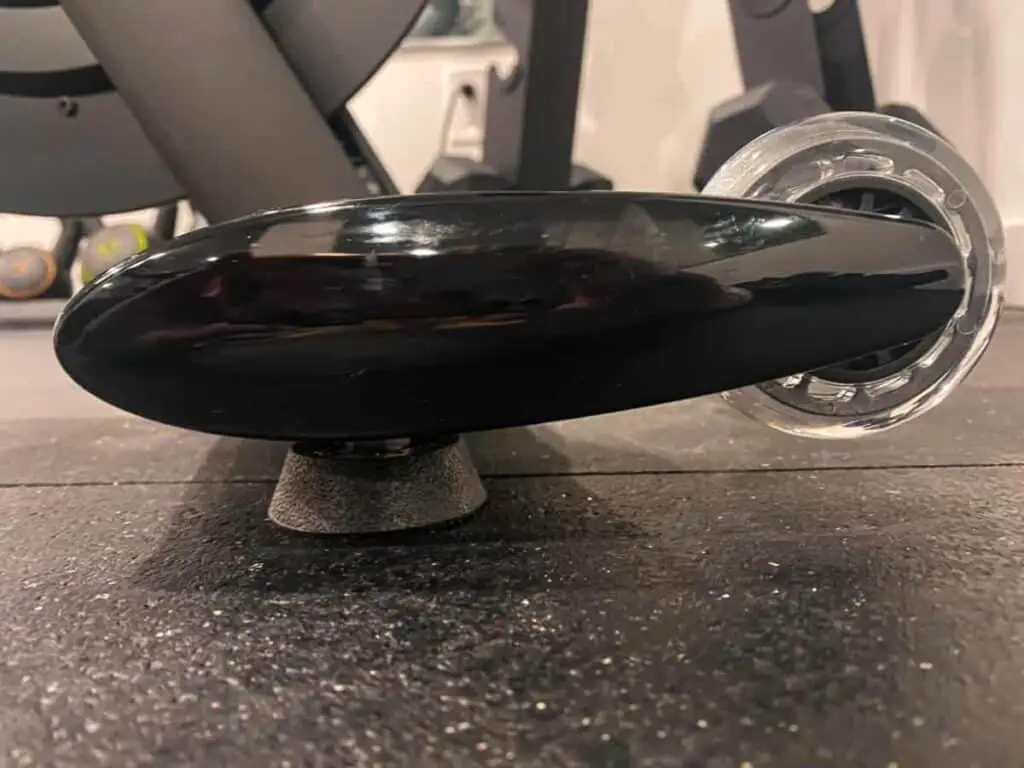Peloton positioned their bikes to cater to those wishing to enjoy the benefits of boutique fitness classes at home. The company sells stationary exercise bikes with a touchscreen and WIFI connection, enabling subscribers to join exercise classes at home. Some riders have complained that their Peloton bike and bike+ wobble and asked how to fix this.
A Peloton bike requires a hard surface. It may wobble when it is not squarely positioned on the floor, which may happen because the Peloton’s stabilizers have not been adjusted correctly, the floor is unevenly set or covered in a material that is not a stable-enough foundation for the Peloton.
There is much more to this exciting exercise equipment than a wobble and a shake. In the following discussion, I will show you how a Peloton bike may become wobbly, as well as a variety of ways to deal with it.
Why Does My Peloton Bike Wobble And How To Fix It?
Discovering why your Peloton bike is wobbling should not be too complicated. There are two primary components of the unit: its stability, and the floor on which it stands. Assessing and fixing or alleviating the problem with your bike requires some testing and tweaking work. You will eliminate possible reasons for the wobble before fixing it and moving on to the next reason.
Does My Peloton Bike Need To Be Stabilized?

Firstly, check the Peloton’s stabilizers and, if necessary, adjust them. You will find the stabilizers under each Peloton base. Ideally, all stabilizers should be extended to the same length. This, however, depends on the floor itself, and stabilizers may not be equally extended. Set the stabilizers firmly on the floor to balance the bike and prevent wobbling.
Stabilizing is done by turning the rubber pads. Move the pad clockwise, if you wish to lower it, and anticlockwise, to pull it up. Once adjusted and balanced, the bike should be leveled without wobbling or rocking. You may need to repeat this action from time to time, as your exercises shake the bike’s frame and can cause it to go off-balance.
Did My Peloton Bike Lose Its Calibration?
The next possible reason for the Peloton bike wobble is calibration, the unit’s output numbers against specific resistance and cadence. Your Peloton bike may be wobbling because it needs to be calibrated. Peloton claims that once the bikes have been factory-calibrated, they do not have to be calibrated again.
However, some Peloton users find that bikes need to be recalibrated from time to time and that calibration helps with bike wobble. If you wish to calibrate your bike, there are several online guidelines to show you how to do it through the Peloton software, using the systems settings option in the Peloton management software.
A calibrated bike would report to the Peloton’s management software the correct resistance the bike raises to the rider’s efforts. If the system is not correctly calibrated, it may send incorrect information to the software. The result shown on the screen will mislead the rider, who will exert extraordinary pressure on the bike, causing a wobble.
Does The Floor Cause My Peloton To Wobble?
If Adjusting the Peloton’s stabilizers and even recalibrating made no difference, and the unit still wobbles, then it is time to check the flooring. Peloton bikes would become unstable and may wobble or shake if put on top of soft flooring like carpets, if the floor is slippery, like a laminate floor or over-polished tiles, and if the surface is uneven, rough, or broken up.
In addition, the Peloton bike is heavy, around 135 pounds, and the human average weight is between 130 to 180 lbs. If the floor cannot withstand this weight, it will likely cause the bike to wobble. The recommended thickness for a plywood sheet is 3/4 inch. Note that carpets that are too thick may also throw the bike off balance.
Based on the location of your home gym, the standard options could be tiles, wood, carpet, linoleum, laminated flooring, or concrete. The assumption is that the unit may wobble because the floor is not strong enough to hold the Peloton firmly when the user pedals on at high speed, especially when they stand on the pedals while holding the handlebars.
The Peloton’s footprint is 36 inches by 72 inches (or 3×6 feet). This is the size of the floor that needs to be covered to stabilize the Peloton bike. Generally speaking, a floor cover (mat, plywood, or both) is recommended for carpets, tiles, laminated floors, hardwood-covered floors, and even concrete floors to level the floor and reduce wobble.
Would A Mat And Plywood Fix My Peloton’s Wobble?
Use a PVC or rubber mat for hard surfaces, including concrete, tiles, and laminated floors, because these mats are both robust and slip-resistant. Some of these products may be bought as a roll and cut to the required dimensions. Others are made of rubber tiles that interlock and connect.
Peloton’s branded high-density bike-mat sets out to provide the equipment stability and balance while also dealing with biker’s sweat. The mat is 36 inches by 72 inches – the right size to cover the same space taken by the bike. Mats are easy to clean and maintain. While stabilizing your bike, the mat also protects your floor from being damaged while riding.
A particular challenge posed by hardwood and carpets is that they may be soft or pliable and provide no solid foundation for the Peloton bike. To resolve, create a two-layered base for the bike. The first layer is a piece of plywood 36 inches by 72 inches and 3/4 of an inch thick in size. On top of the plywood layer, you put a bike-mat – cut to the same size.
If you think a mat would resolve your particular problem then we have a great recommendation, check it out here!

Also, if you are considering getting a mat for your Peloton bike check out this article for more information.
Do The Touchscreen Or Handlebars Cause My Peloton Bike To Wobble?
The touchscreen and the handlebars may also cause wobbles. The peloton touchscreen (21.5 inches in the bike older models, and the heavier 23.8 inches on the bike +) is used to stream classes and training sessions. It is attached to the handlebars.
Some touchscreens wobble and vibrate while riding, making it difficult to watch the touchscreen. Touchscreen wobbles manifest in the bike wobbling, shaking, or vibrating from side to side at a high cadence. Sometimes this movement is more pronounced when riding without holding the handlebars.
How To Fix Touch Screen And Handlebar Wobble
One can fix, or at least, reduce the touchscreen’s wobble on a Peloton bike or bike + by tightening the screws under the monitor screen’s display mount, as well as at the base (or ‘stem’) of the handlebars, using a 1/8″ Allen wrench. In addition, on the bike +, one can swivel the screen until it reveals a screw at the base of the swivel unit and tighten up this screw.
Firstly, handlebars’ wobbles can be seen by releasing the Peloton bike’s front lever. The lever looks differently on the bike and the bike+, but both levers are positioned at the front of the Handlebars’ stem and function the same way. Set the Handlebars at your required position (marked from A to Max), hold it firmly, and tighten the screws again.
Conclusion
Peloton’s bike seeks to offer users a luxury proposition of having boutique fitness facilities in their homes. The bike and the online classes – both recorded and live – and the ability to track and map one’s rate of progress is part of Peloton’s ambitious plan.
While some users felt that their Peloton bike wobbles, the reasons are not difficult to diagnose and fix, the first possible source for the bike’s wobbles is that the bike’s stabilizers are not set correctly.
The second possible reason for the bike to wobble is the flooring, specifically the patch of the floor on which the Peloton bike is positioned. This, too, is managed by laying down a mat, a sheet of plywood, or both.







